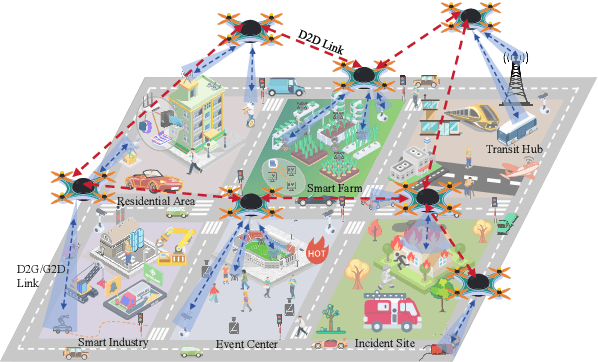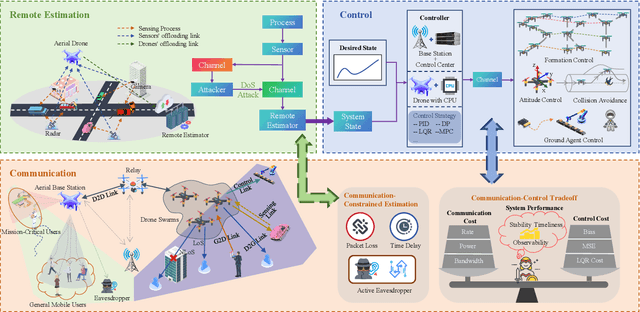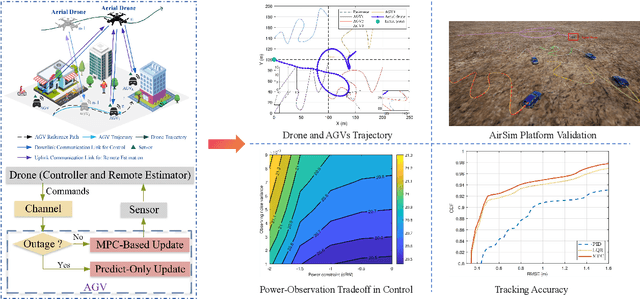Dong In Kim
Sherman
Sum-Rate Maximization for Uplink Segmented Waveguide-Enabled Pinching-Antenna Systems
Dec 23, 2025Abstract:A multiuser uplink transmission framework based on the segmented waveguide-enabled pinching-antenna system (SWAN) is proposed under two operating protocols: segment selection (SS) and segment aggregation (SA). For each protocol, the achievable uplink sum-rate is characterized for both time-division multiple access (TDMA) and non-orthogonal multiple access (NOMA). Low-complexity placement methods for the pinching antennas (PAs) are developed for both protocols and for both multiple-access schemes. Numerical results validate the effectiveness of the proposed methods and show that SWAN achieves higher sum-rate performance than conventional pinching-antenna systems, while SA provides additional performance gains over SS.
Cost Minimization for Space-Air-Ground Integrated Multi-Access Edge Computing Systems
Oct 24, 2025Abstract:Space-air-ground integrated multi-access edge computing (SAGIN-MEC) provides a promising solution for the rapidly developing low-altitude economy (LAE) to deliver flexible and wide-area computing services. However, fully realizing the potential of SAGIN-MEC in the LAE presents significant challenges, including coordinating decisions across heterogeneous nodes with different roles, modeling complex factors such as mobility and network variability, and handling real-time decision-making under partially observable environment with hybrid variables. To address these challenges, we first present a hierarchical SAGIN-MEC architecture that enables the coordination between user devices (UDs), uncrewed aerial vehicles (UAVs), and satellites. Then, we formulate a UD cost minimization optimization problem (UCMOP) to minimize the UD cost by jointly optimizing the task offloading ratio, UAV trajectory planning, computing resource allocation, and UD association. We show that the UCMOP is an NP-hard problem. To overcome this challenge, we propose a multi-agent deep deterministic policy gradient (MADDPG)-convex optimization and coalitional game (MADDPG-COCG) algorithm. Specifically, we employ the MADDPG algorithm to optimize the continuous temporal decisions for heterogeneous nodes in the partially observable SAGIN-MEC system. Moreover, we propose a convex optimization and coalitional game (COCG) method to enhance the conventional MADDPG by deterministically handling the hybrid and varying-dimensional decisions. Simulation results demonstrate that the proposed MADDPG-COCG algorithm significantly enhances the user-centric performances in terms of the aggregated UD cost, task completion delay, and UD energy consumption, with a slight increase in UAV energy consumption, compared to the benchmark algorithms. Moreover, the MADDPG-COCG algorithm shows superior convergence stability and scalability.
Joint AoI and Handover Optimization in Space-Air-Ground Integrated Network
Sep 16, 2025Abstract:Despite the widespread deployment of terrestrial networks, providing reliable communication services to remote areas and maintaining connectivity during emergencies remains challenging. Low Earth orbit (LEO) satellite constellations offer promising solutions with their global coverage capabilities and reduced latency, yet struggle with intermittent coverage and limited communication windows due to orbital dynamics. This paper introduces an age of information (AoI)-aware space-air-ground integrated network (SAGIN) architecture that leverages a high-altitude platform (HAP) as intelligent relay between the LEO satellites and ground terminals. Our three-layer design employs hybrid free-space optical (FSO) links for high-capacity satellite-to-HAP communication and reliable radio frequency (RF) links for HAP-to-ground transmission, and thus addressing the temporal discontinuity in LEO satellite coverage while serving diverse user priorities. Specifically, we formulate a joint optimization problem to simultaneously minimize the AoI and satellite handover frequency through optimal transmit power distribution and satellite selection decisions. This highly dynamic, non-convex problem with time-coupled constraints presents significant computational challenges for traditional approaches. To address these difficulties, we propose a novel diffusion model (DM)-enhanced dueling double deep Q-network with action decomposition and state transformer encoder (DD3QN-AS) algorithm that incorporates transformer-based temporal feature extraction and employs a DM-based latent prompt generative module to refine state-action representations through conditional denoising. Simulation results highlight the superior performance of the proposed approach compared with policy-based methods and some other deep reinforcement learning (DRL) benchmarks.
Toward Multi-Functional LAWNs with ISAC: Opportunities, Challenges, and the Road Ahead
Aug 24, 2025



Abstract:Integrated sensing and communication (ISAC) has been envisioned as a foundational technology for future low-altitude wireless networks (LAWNs), enabling real-time environmental perception and data exchange across aerial-ground systems. In this article, we first explore the roles of ISAC in LAWNs from both node-level and network-level perspectives. We highlight the performance gains achieved through hierarchical integration and cooperation, wherein key design trade-offs are demonstrated. Apart from physical-layer enhancements, emerging LAWN applications demand broader functionalities. To this end, we propose a multi-functional LAWN framework that extends ISAC with capabilities in control, computation, wireless power transfer, and large language model (LLM)-based intelligence. We further provide a representative case study to present the benefits of ISAC-enabled LAWNs and the promising research directions are finally outlined.
Advancing the Control of Low-Altitude Wireless Networks: Architecture, Design Principles, and Future Directions
Aug 11, 2025



Abstract:This article introduces a control-oriented low-altitude wireless network (LAWN) that integrates near-ground communications and remote estimation of the internal system state. This integration supports reliable networked control in dynamic aerial-ground environments. First, we introduce the network's modular architecture and key performance metrics. Then, we discuss core design trade-offs across the control, communication, and estimation layers. A case study illustrates closed-loop coordination under wireless constraints. Finally, we outline future directions for scalable, resilient LAWN deployments in real-time and resource-constrained scenarios.
Predictive Control over LAWN: Joint Trajectory Design and Resource Allocation
Jul 03, 2025



Abstract:Low-altitude wireless networks (LAWNs) have been envisioned as flexible and transformative platforms for enabling delay-sensitive control applications in Internet of Things (IoT) systems. In this work, we investigate the real-time wireless control over a LAWN system, where an aerial drone is employed to serve multiple mobile automated guided vehicles (AGVs) via finite blocklength (FBL) transmission. Toward this end, we adopt the model predictive control (MPC) to ensure accurate trajectory tracking, while we analyze the communication reliability using the outage probability. Subsequently, we formulate an optimization problem to jointly determine control policy, transmit power allocation, and drone trajectory by accounting for the maximum travel distance and control input constraints. To address the resultant non-convex optimization problem, we first derive the closed-form expression of the outage probability under FBL transmission. Based on this, we reformulate the original problem as a quadratic programming (QP) problem, followed by developing an alternating optimization (AO) framework. Specifically, we employ the projected gradient descent (PGD) method and the successive convex approximation (SCA) technique to achieve computationally efficient sub-optimal solutions. Furthermore, we thoroughly analyze the convergence and computational complexity of the proposed algorithm. Extensive simulations and AirSim-based experiments are conducted to validate the superiority of our proposed approach compared to the baseline schemes in terms of control performance.
From Ground to Sky: Architectures, Applications, and Challenges Shaping Low-Altitude Wireless Networks
Jun 14, 2025Abstract:In this article, we introduce a novel low-altitude wireless network (LAWN), which is a reconfigurable, three-dimensional (3D) layered architecture. In particular, the LAWN integrates connectivity, sensing, control, and computing across aerial and terrestrial nodes that enable seamless operation in complex, dynamic, and mission-critical environments. In this article, we introduce a novel low-altitude wireless network (LAWN), which is a reconfigurable, three-dimensional (3D) layered architecture. Different from the conventional aerial communication systems, LAWN's distinctive feature is its tight integration of functional planes in which multiple functionalities continually reshape themselves to operate safely and efficiently in the low-altitude sky. With the LAWN, we discuss several enabling technologies, such as integrated sensing and communication (ISAC), semantic communication, and fully-actuated control systems. Finally, we identify potential applications and key cross-layer challenges. This article offers a comprehensive roadmap for future research and development in the low-altitude airspace.
Curriculum Learning With Counterfactual Group Relative Policy Advantage For Multi-Agent Reinforcement Learning
Jun 09, 2025Abstract:Multi-agent reinforcement learning (MARL) has achieved strong performance in cooperative adversarial tasks. However, most existing methods typically train agents against fixed opponent strategies and rely on such meta-static difficulty conditions, which limits their adaptability to changing environments and often leads to suboptimal policies. Inspired by the success of curriculum learning (CL) in supervised tasks, we propose a dynamic CL framework for MARL that employs an self-adaptive difficulty adjustment mechanism. This mechanism continuously modulates opponent strength based on real-time agent training performance, allowing agents to progressively learn from easier to more challenging scenarios. However, the dynamic nature of CL introduces instability due to nonstationary environments and sparse global rewards. To address this challenge, we develop a Counterfactual Group Relative Policy Advantage (CGRPA), which is tightly coupled with the curriculum by providing intrinsic credit signals that reflect each agent's impact under evolving task demands. CGRPA constructs a counterfactual advantage function that isolates individual contributions within group behavior, facilitating more reliable policy updates throughout the curriculum. CGRPA evaluates each agent's contribution through constructing counterfactual action advantage function, providing intrinsic rewards that enhance credit assignment and stabilize learning under non-stationary conditions. Extensive experiments demonstrate that our method improves both training stability and final performance, achieving competitive results against state-of-the-art methods. The code is available at https://github.com/NICE-HKU/CL2MARL-SMAC.
Joint User Association and Beamforming Design for ISAC Networks with Large Language Models
Jun 05, 2025Abstract:Integrated sensing and communication (ISAC) has been envisioned to play a more important role in future wireless networks. However, the design of ISAC networks is challenging, especially when there are multiple communication and sensing (C\&S) nodes and multiple sensing targets. We investigate a multi-base station (BS) ISAC network in which multiple BSs equipped with multiple antennas simultaneously provide C\&S services for multiple ground communication users (CUs) and targets. To enhance the overall performance of C\&S, we formulate a joint user association (UA) and multi-BS transmit beamforming optimization problem with the objective of maximizing the total sum rate of all CUs while ensuring both the minimum target detection and parameter estimation requirements. To efficiently solve the highly non-convex mixed integer nonlinear programming (MINLP) optimization problem, we propose an alternating optimization (AO)-based algorithm that decomposes the problem into two sub-problems, i.e., UA optimization and multi-BS transmit beamforming optimization. Inspired by large language models (LLMs) for prediction and inference, we propose a unified framework integrating LLMs with convex-based optimization methods. First, we propose a comprehensive design of prompt engineering, including few-shot, chain of thought, and self-reflection techniques to guide LLMs in solving the binary integer programming UA optimization problem. Second, we utilize convex-based optimization methods to handle the non-convex beamforming optimization problem based on fractional programming (FP), majorization minimization (MM), and the alternating direction method of multipliers (ADMM) with an optimized UA from LLMs. Numerical results demonstrate that our proposed LLM-enabled AO-based algorithm achieves fast convergence and near upper-bound performance with the GPT-o1 model, outperforming various benchmark schemes.
Empowering Intelligent Low-altitude Economy with Large AI Model Deployment
May 28, 2025Abstract:Low-altitude economy (LAE) represents an emerging economic paradigm that redefines commercial and social aerial activities. Large artificial intelligence models (LAIMs) offer transformative potential to further enhance the intelligence of LAE services. However, deploying LAIMs in LAE poses several challenges, including the significant gap between their computational/storage demands and the limited onboard resources of LAE entities, the mismatch between lab-trained LAIMs and dynamic physical environments, and the inefficiencies of traditional decoupled designs for sensing, communication, and computation. To address these issues, we first propose a hierarchical system architecture tailored for LAIM deployment and present representative LAE application scenarios. Next, we explore key enabling techniques that facilitate the mutual co-evolution of LAIMs and low-altitude systems, and introduce a task-oriented execution pipeline for scalable and adaptive service delivery. Then, the proposed framework is validated through real-world case studies. Finally, we outline open challenges to inspire future research.
 Add to Chrome
Add to Chrome Add to Firefox
Add to Firefox Add to Edge
Add to Edge